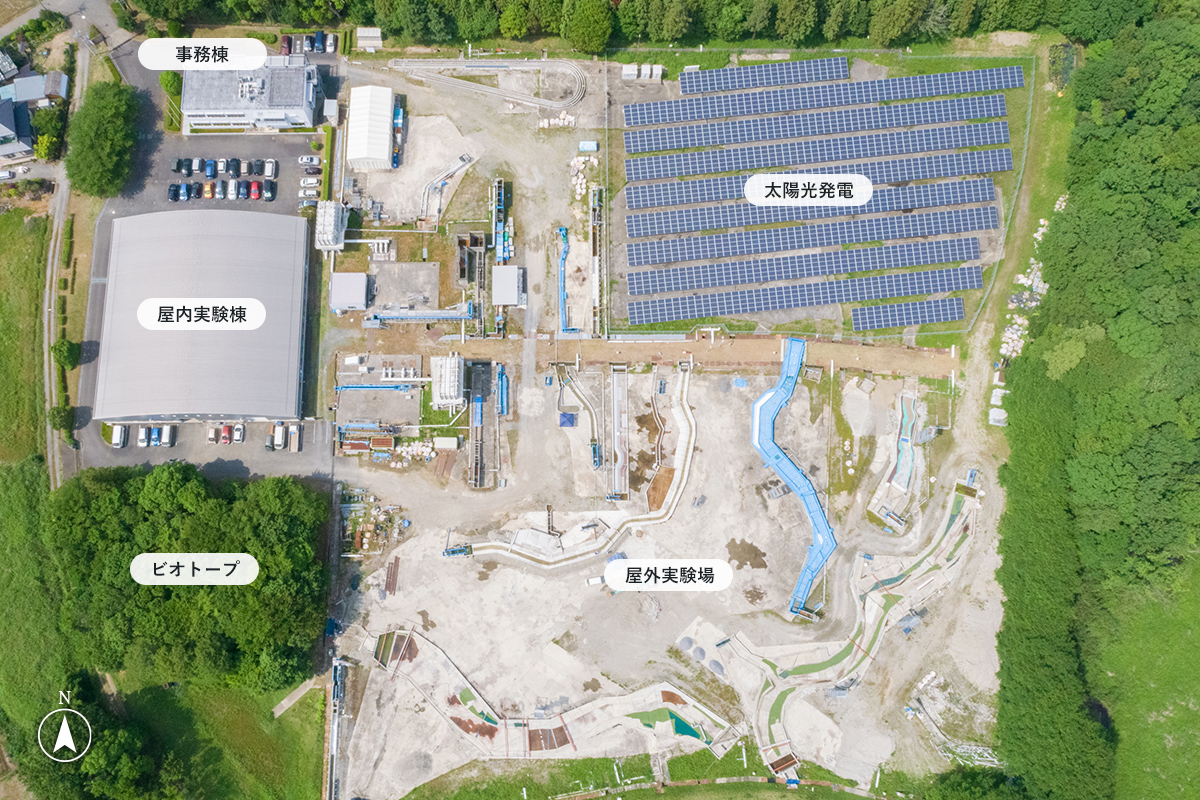Facility Overview

PACIFIC CONSULTANTS CO., LTD.,
Tsukuba Research Center
642-1 Sakuya, Tsukuba City, Ibaraki Prefecture, 300-4204
TEL: 029-869-1041/FAX: 029-869-0269
Facility Equipment Overview
| Outdoor Experiment Site | Area | 17,000m², 5,050m²: Used for solar power generation |
|---|---|---|
| Water Supply Capacity | System 1: 0.75m³/s, System 2: 0.70m³/s | |
| Water Supply Facilities | System 1: φ200-500mm x 8 locations System 2: φ100-400mm x 16 locations |
|
| Indoor Experiment Building (Test Yard) |
Area, Height | 36m×45m: 1890m², height 5.5m~10m |
| Water Supply Facilities | φ400mm x 4 places, φ100mm x 4 places | |
| Environmental Analysis Room | Floor Space | 170m² |
| Biotope | Area | 1,500m² |
The facility is divided into an outdoor laboratory, an indoor laboratory, and an environmental analysis room.
The outdoor experiment site and indoor experiment building are mainly used for hydraulic model experiment and waterway experiments of rivers and erosion control facilities. The environmental analysis room analyzes air, water quality, bottom sediment, soil, odors, pesticides, etc.
Access
PACIFIC CONSULTANTS CO., LTD.,
Tsukuba Research Center
642-1 Sakuya, Tsukuba City, Ibaraki Prefecture, 300-4204
(MAPCODE: 123 350 833*10)
For those coming from Tokyo
- Train
-
Take the Tsukuba Express (TX) to Kenkyu-gakuen Station or
Get off at Tsukuba Station and then take a car or bus from the station.1. Automobiles
Taxi, etc.: Approximately 30 minutes ride from both stations
2. Bus
*Trains departing from and arriving at Kenkyu Gakuen Station take longer, but there are more buses departing from Tsukuba Station. Transportation IC cards are accepted.
- Kenkyu Gakuen Station * Departure and arrival
Community bus "Tsuku Bus"
(Sakuoka Shuttle: Kenkyu Gakuen Station → Toyosato Forest → Kitabu Industrial Park → Teragu: approx. 50 minutes) Tsukuba bus schedule
From "Kenkyu-gakuen Station", get off at "Tsukuriya" and walk for 9 minutes
* Rapid trains do not stop here, one stop before the final stop, Tsukuba Station. - Tsukuba Station (Tsukuba Center)
Kanto Railway Purple Bus Shimotsuma-Tsukuba Center Line (approx. 35 mins) Bus timetable
From Tsukuba Center, bus stop No. 5, route No. 71, get off at Higashi Tsukuriya and walk for 9 minutes
- Kenkyu Gakuen Station * Departure and arrival
- Express Bus
- From Tokyo Station Yaesu South Exit, take the Joban Expressway Bus bound for Tsukuba Center
Get off at the last stop "Tsukuba Center" (approximately 70 minutes from Tokyo Station)
From "Tsukuba Center", take the above route bus and get off at "Higashi Tsukuriya", then walk for 9 minutes
- Car
- Joban Expressway Sakura-Tsuchiura Interchange (approx. 30 minutes from Misato Interchange)
About 35 minutes via Gakuen Higashi Odori/Prefectural Route 55 and National Route 408
History
The predecessor of this center was a hydraulic experiment station that opened in 1979 on a site of approximately one hectare on the outskirts of Maebashi City, Gunma Prefecture.
-
1984 (Showa 59)
December
Moved to Tsukuba City, Ibaraki Prefecture and established the "Tsukuba Experimental Site" on a site of approximately 2 hectares.
-
1987 (Showa 62)
October
The total site area was expanded to approximately 4 hectares to accommodate larger-scale experiments.
-
1992 (Heisei 4)
April
Completion of office building, 2-story steel-framed building, total floor area 660m²
-
2001 (Heisei 13)
August
Constructed a laboratory capable of carrying out a variety of experiments, tests, and technological development, opened an environmental analysis room, and changed the name to "Tsukuba Research Center."
Main Achievements

Tokaido Main Line Fujikawa Bridge
On August 20, 1982, heavy rains caused by Typhoon No. 10 caused the fourth pier of the Tokaido Main Line Fuji River Bridge's outbound line toppled, washing away two truss girders. The flood flow velocity reached 8m/s, and it was estimated that the flowing water acted on the overturned pier at an angle of approximately 10 degrees. These estimates were verified by hydraulic model experiment.
Photo: Hdraulic model experiment recreating a flood

Great East Japan Earthquake: "Consideration of Resilient Coastal Embankments"
Learning from the Tohoku Pacific Ocean Earthquake, it became necessary to develop and improve coastal embankment structures that would be able to maintain their effectiveness even when tsunami heights exceeded the heights they were designed for. Hydraulic model experiment were conducted to examine resilient coastal embankment structures.
Contractor: National Institute for Land and Infrastructure Management

